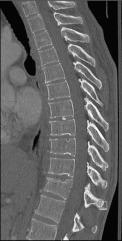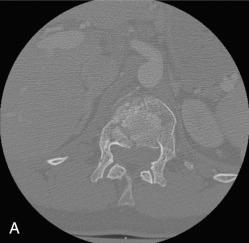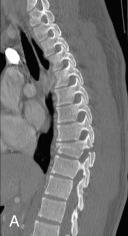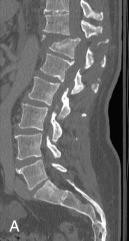Physical Address
304 North Cardinal St.
Dorchester Center, MA 02124
Trauma to the thoracolumbar spine in athletes is common and can vary from minor sprain to major spinal fracture. Severe and potentially unstable spinal injuries are uncommon in sports-related trauma, but may be seen in athletes participating in contact sports or high velocity accidents. In addition to the contact and collision sports, athletes participating in certain noncontact sports like gymnastics, diving and weight lifting are also at risk for back trauma. Treatment of the injury and the recovery thereafter also varies widely depending on the pathology.
Irrespective of the underlying pathology, acute back pain is the most common symptom related to back trauma in athletes. The incidence of low back pain in athletes has been reported to be as high as 30%, and it can affect all athletes regardless of the position or the intensity of play. Internal disc disruption is the most common cause of low back pain in young athletes. Lumbar disc disruption can cause a variety of symptoms, including back pain to radicular leg pain. Some specific spine injuries are more common in certain sports ( Table 129.1 ). Spondylolysis is more common in adolescent athletes, whereas internal disc disruption is more common between the ages of 18 and 50, and facet joints as well as sacroiliac (SI) joints more commonly caused back pain after the age of 50. This chapter will cover the risk factors, history, examination, and imaging in the diagnosis of traumatic thoracolumbar spine injuries, and review the decision-making process and return-to-play (RTP) consideration in these athletes.
| Sports | Spine Injury/Pathology |
|---|---|
| Rowers, and male football players, offensive and defensive linemen | Disc herniation |
| Baseball players and swimmers, gymnasts, weightlifters | Lumbar disc degeneration |
| Linemen, gymnasts, weightlifters, track and field athletes, and soccer players, dance, figure skating | Isthmic spondylolisthesis, spondylolysis |
| Gymnastics, wrestling, volleyball, and weight lifting | Vertebral body apophyseal avulsion fracture |
| Joggers | Stress fracture of the lamina |
| Ballet dancers | Fracture of the pedicle |
| Ballerina | Facet stress fractures |
| Classic ballet, rhythmic gymnastics, swimming, throwing, and serving, single arm throwing sports | Minor spine curves, scoliosis |
During growth spurt the rate of bone growth surpasses the pace of muscle and ligaments growth, which leads to muscle imbalance and inflexibility. Overuse injuries are more common during this period. Avulsion of the ring apophyses as a secondary ossification center can happen due to repetitive flexion exercises. Disc can also herniate through the ring apophysis. Spina bifida or dysplasia of the posterior elements is a risk factor for spondylolysis. Less skeletally mature children are at increased risk of spine injury when playing contact sports with physically larger players.
Hyperlordosis of the lumbar spine due to hip flexor or hamstring tightness, genu recurvatum, increased femoral anteversion, abdominal muscle weakness, or increased thoracic kyphosis can also exert extra stress on the posterior spinal elements. Other risk factors include malalignment of the lower extremities and pelvis, weak lower abdominal muscles, and abnormal pelvis and sacral morphology. Increased pelvis incidence increases to a shear forces across the L5 pars interarticularis. Decreased pelvis incidence can also damage the L5 pars through the nutcracker mechanism. Both situations can result in spondylolysis and progress to spondylolisthesis. Sex-specific spine injury and pathologies are summarized in Table 129.2 .
| Male | Female |
|---|---|
| Scheuermann kyphosis | Spondylolysis in ballet, figure skating, and gymnastics Spondylolisthesis (higher in children of European descent than in those of African descent) Scoliosis Sacral stress fractures in long-distance runners |
A complete history of the injury that led to the onset of back pain, the mechanism of injury, location and radiation of pain, exacerbating or alleviating activities, the type of sport(s) that the athlete has been involved in, the training regimen, any recent increase in the volume or intensity of training, the position played, diet, menstrual history, previous injuries, and treatments should be obtained. Red flags include constitutional symptoms, history of infection, or cancer, weight loss, night sweats, fevers, chronic cough, immunocompromised patients, intravenous drug use, recent infection, and nonmechanical back pain worse at night. Urinary or stool incontinence should raise the concern about myelopathy or cauda equina syndrome. Cauda equina syndrome might also include lower extremity weakness/numbness, saddle anesthesia, and sexual dysfunction. Myelopathy can be caused by vertebrae fracture, epidural hematoma and retropulsion, or disc herniation at the level of the cervical or thoracic spine. The symptoms include ataxia, motor weakness, and in cases of cervical spinal cord impingement, the patient will have problems with the coordination of the hands. Performance-enhancing steroids might compromise immune system and increase the propensity to infection. Wheelchair-bound athletes might also develop spine infections as a result of decubitus ulcer or recurrent urinary tract infection.
Physical exam should start with inspection of the back and extremities, palpation of the spine, and evaluation of the gait and range of motion (ROM) of the spine. Neurologic exam includes testing the strength, sensation, and reflexes. Nerve root impingement will cause radicular pain, possible sensory loss, weakness, or diminished reflexes. Looking at the level of the shoulders and pelvis as well as the Adam forward bending test can help identify scoliosis. Skin abnormalities such as hemangiomas, café-au-lait spots, skin dimples, or hairy patches may be associated with underlying spine abnormalities. The positive straight leg raise (SLR) test is the provocation of radicular pain after 30 to 60 degrees of hip flexion while the patient is in the supine or sitting position.
Pain with spine flexion can suggest injury to the anterior elements of the spine, including vertebrae fractures or muscle strain or disc disruption. Limitation of the spine forward flexion might be due to tight hamstrings. Pain with extension might indicate injury to the posterior spinal elements or SI joint.
In the absence of red flag signs and after a thorough history and physical exam, the treatment of the athlete can be started without obtaining spine images, especially in cases of nonspecific acute low back pain. It is very important to avoid any unnecessary radiation to young athletes. Spine imaging is more appropriate when there is a history of trauma, and history of spine abnormalities or spondylolysis, or if the low back pain failed to respond to nonoperative management for 6 weeks or more. Magnetic resonance imaging (MRI) is indicated in the presence of red flag signs, positive neurologic findings, history of infection or metastases, symptoms refractory to nonoperative management, and planning interventional procedures.
Thoracolumbar junction is the most common site for thoracic and lumbar spinal trauma. The most common primary force vectors responsible for spinal fractures include axial compression, lateral compression, flexion, extension, distraction, shear, and rotation. These individual vectors or their combinations can explain most of the commonly seen spinal injuries.
Spinal stability is one of the most important treatment determining factors in case of spinal trauma. It is described in terms of mechanical spinal stability and neurologic stability. Mechanical spinal stability defines the structural integrity of the spine and its ability to resist deforming forces. The Dennis classification system for three column theory is commonly used for mechanical spinal stability. Anterior column is composed of the anterior longitudinal ligament (ALL), anterior vertebral body, and anterior annulus. The middle column comprises the posterior vertebral body, posterior annulus, and posterior longitudinal ligament (PLL), while the ligamentum flavum, neural arch, facet joints/capsule, and posterior ligamentous complex constitute posterior column. Involvement of two or more columns is considered mechanically unstable and may warrant stabilization. The presence or absence of neurologic deficit defines the neurologic stability of the spine.
The Thoracolumbar Injury Classification and Severity Score (TLICS) is one of the commonly used classification systems that incorporates concepts of both mechanical and neurologic stability to help guide surgical versus conservative management of spinal fractures. Three injury characteristics, including (1) morphology of injury determined by radiographic appearance, (2) integrity of the posterior ligamentous complex, and (3) neurologic status of the patient, are analyzed and scored. A total score of 5 or more is considered an indication for surgical spinal stabilization ( Table 129.3 ).
| Type | Qualifiers | Points |
|---|---|---|
| Injury Morphology | ||
| Compression | 1 | |
| Burst | 2 | |
| Translational/rotational | 3 | |
| Distraction | 4 | |
| Integrity of Posterior Ligamentous Complex | ||
| Intact | 0 | |
| Indeterminate | 2 | |
| Injured | 3 | |
| Neurologic Status | ||
| Intact | 0 | |
| Nerve root | 2 | |
| Cord/conus | Complete | 2 |
| Incomplete | 3 | |
| Cauda equine | 3 | |
Compression fractures, though common in the general aging population, are relatively rare in young athletes. These fractures result from axial compression force with the resultant anterior column failure. It may involve superior/inferior or both end plates or anterior cortex buckling ( Fig. 129.1 ). These fractures are usually mechanically stable and rarely neurologically involved. Plain radiographs/CT imaging is generally sufficient, and MRI is indicated only in suspected posterior complex/neurologic involvement. The prognosis is usually favorable and may be treated with observation/bracing. Surgical stabilization may be considered only in case of severe height loss (more than 50%) and significant kyphosis (more than 30 degrees), which is suggestive of potential posterior ligamentous complex involvement and possible spinal instability.

Burst fractures are a type of compression fracture related to high-energy axial loading spinal trauma that results in disruption of the posterior vertebral body cortex with retropulsion into the spinal canal ( Fig. 129.2 ). Distinction between compression and burst fractures may be difficult on plain radiographs and CT scan can help. MRI can provide substantial information on the involvement of the posterior ligamentous complex.

These fractures may be stable or unstable and can have varying degree of neurologic involvement. Considerations for surgery include neurologic and mechanical instability. Neurologic involvement may require surgical decompression and stabilization. These fractures may be amenable to bracing/surgical stabilization, depending on the stability of spinal column.
Chance fractures are caused by flexion-distraction force vectors and involve axial compression of anterior column with transverse/distraction injury to middle/posterior columns ( Fig. 129.3 ). Posterior column involvement could be bony or ligamentous. Ligament injuries may be evident by widening of facet joints/interspinous space on radiographs/CT. MRI is usually indicated and can identify the ligamentous involvement. These injuries are common with restrained car lap seatbelts (seatbelt fractures) and commonly associated with intra-abdominal injuries. Bony Chance fractures may be considered for bracing, while ligamentous involvement of posterior column may usually require surgical stabilization.

These are highly unstable injuries caused by combination of various force vectors commonly seen in high energy trauma. All three spinal columns are involved with resultant spinal instability ( Fig. 129.4 ). Facet joint disruption (fracture/dislocation) is associated with vertebral body translation. Spinal cord/conus with neurologic injuries is involved in 50% to 60% of these injuries. These injuries are typically both neurologically and mechanically unstable and require surgical intervention.

These are relatively uncommon injuries and are usually seen in ankylosed spine associated with ankylosing spondylitis (AS) or diffuse idiopathic skeletal hyperostosis (DISH).
Become a Clinical Tree membership for Full access and enjoy Unlimited articles
If you are a member. Log in here